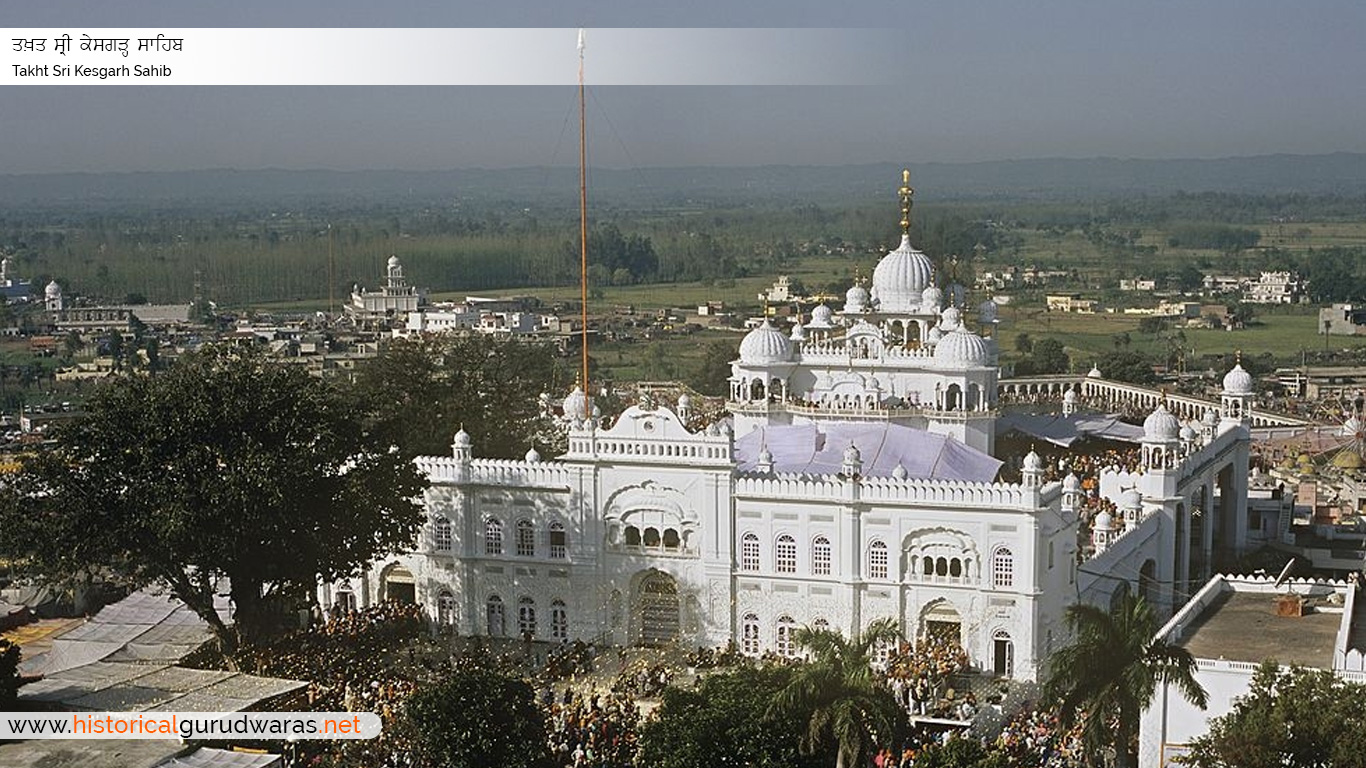Takhat Sri Kesgarh Sahib

q^q sRI kysgVH swihb
AnMdpur swihb, rUpngr (ropV) ijlHy dw iek Sihr hY[ ieh pMjwb rwj ivc iSvwilk phwVIAW dy iknwry Aqy sqluj dirAw dy nzdIk ieh iek piv~qr AsQwn hY[ ies AsQwn ’qy gurU qyZ bhwdr Aqy gurU goibMd isMG jI ny invws kIqw[ ies AsQwn ’qy gurU goibMd isMG jI ny 1699 eI: ivc ^wlsw pMQ dI sQwpnw kIqI[ ieh Sihr is~K Drm dy “pMj q^qW” iv~coN iek gurduAwrw sRI kysgVH swihb hY[
ieh Sihr is~K Drm iek qIrQ AsQwn hY[ bsMq dy mOsm ivc holy-mh~ly dOrwn ieQy is~KW dw sB qoN v`fw iek~T huMdw hY
Takhat Sri Kesgarh Sahib
Takht Sri Keshgarh Sahib is the birthplace of the Khalsa. Amid the Shivalik hills, it is situated on the bank of the Satluj. The beat on the Ranjit Nagara has been striking a terror in the minds of the tyrants. For the common man its resonance came to be a divine melody, his guardian angel. He bowed in obeisance to it. It is the place that commemorates the miracle of ‘celebrating the scum of humanity’ and a wonder of the divine and transcendent guru-disciple matrix. After purchasing land of Makhowal, Sri Guru Tegh Bahadur Sahib designated it as Chak Nanki. Later, it came to be popularized as Anandpur Sahib. When Bhai Jaita presented himself to the Great Guru Sri Guru Gobind Singh Ji with reverential, decapitated head of Sri Guru Tegh Bahadur Sahib, the former burst out spontaneously: ‘This is the ground for founding the Panth….’ It is the place where Five Piyaras offered their heads to the Guru Playfully. The divine nectar (Amrit) was prepared in a broad metallic vessel, with a mini but broad rapier and the Piyaras were baptised by the Great Guru.
The Khalsa is my form
I live within the Khalsa…
The Khalsa is my Satguru
It was this place that is the starting point of India’s decisive struggle for independence in his family. The struggle continued until the saffron-coloured flag was hoisted on the Royal Fort at Lahore. So much is the Khalsa attached to this hallowed place that the Sikh feels elated to be called a dweller of ANANDPURI.
Anandpur Sahib is a city in Rupnagar district (Ropar), on the edge of Shivalik Hills, Indian state of Punjab. Located near the Sutlej River, the city is one of the most sacred places in Sikhism, being the place where the last two Sikh Gurus lived, Guru Teg Bahadur Ji and Guru Gobind Singh Ji. this is the place where Guru Gobind Singh Ji founded the Khalsa Panth in 1699. The city is home to Kesgarh Sahib Gurdwara, one of the five Takhts in Sikhism.
The city is a pilgrimage site in Sikhism. It is the venue of the largest annual Sikh gathering and festivities during Hola Mohalla in the spring season.
Anandpur Sahib was founded in June 1665 by the ninth Sikh Guru, Guru Tegh Bahadur. He previously lived in Kiratpur, but given the disputes with Ram Rai – the elder son Guru Har Rai and other sects of Sikhism, he moved to village in Makhoval. He named it Chakk Nanaki after his mother. In 1675, Guru Tegh Bahadur was tortured and beheaded for refusing to convert to Islam under the orders of the Mughal Emperor Aurangzeb, a martyrdom that led Sikhs to rename the town to Anandpur and crown his son Gobind Das as per his orders (also known as Gobind Rai) as his successor and famous as Guru Gobind Singh.
The village grew into town, likely dramatically state Louis E. Fenech and W. H. McLeod, as Sikhs moved near Guru Gobind Singh. The growing strength of Sikhs in Anandpur under the tenth Guru, after the execution of the ninth Guru, raised concerns of the neighboring Pahari rajas - the vassals of the Mughal Empire, along with the Mughal ruler Aurangzeb. In 1693, Aurangzeb issued an order that banned large gatherings of Sikhs such as during the festival of Baisakhi. In 1699, Guru Gobind Singh founded the Khalsa panth and gathered a large armed militia. This triggered Aurangzeb and his vassal Hindu kings around Anandpur to blockade Anandpur
Images of Takhat Sri Kesgarh Sahib




Contact Information of Takhat Sri Kesgarh Sahib
| Address : | Address Here | |
| City : | City | |
| State / Province : | State | |
| Pin / Zip : | 160022 | |
| Country : | Country |
| ISD / Country Code : | 91 | |
| STD Code : | 172 | |
| Phone : | 266 3108 | |
| Mobile : | 9815762315 |
| Email : |

/golden-temple-travel-guide.jpg)


